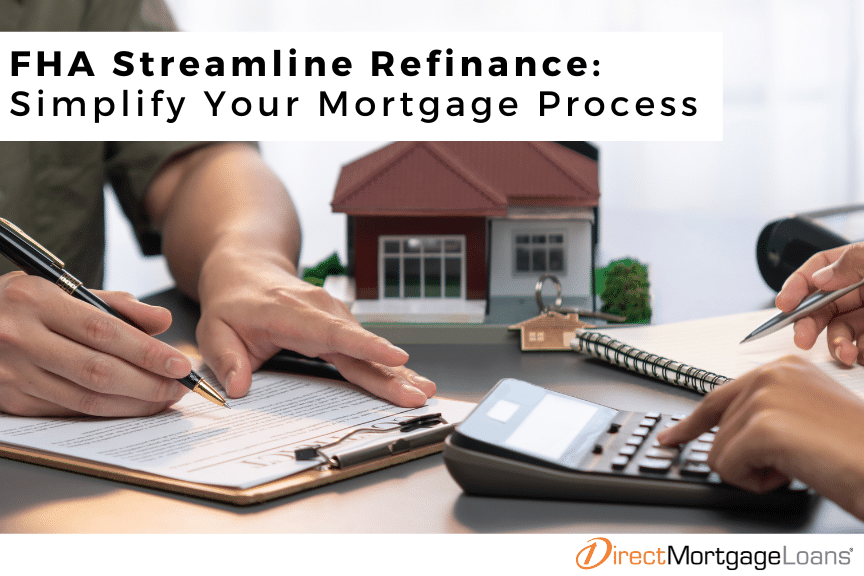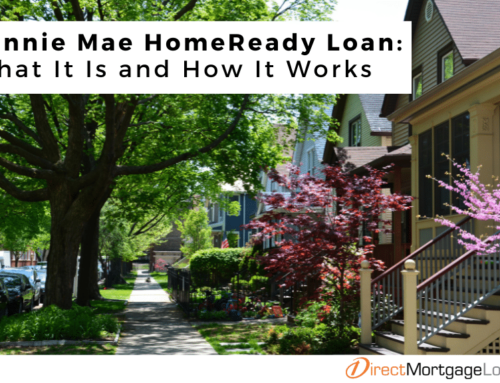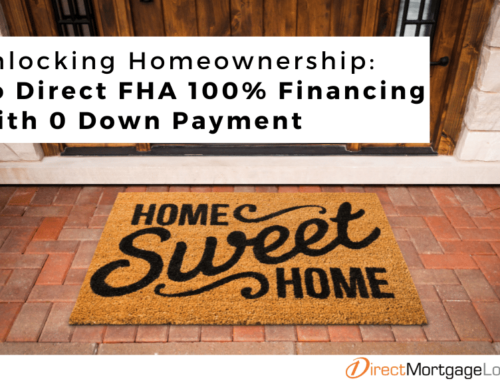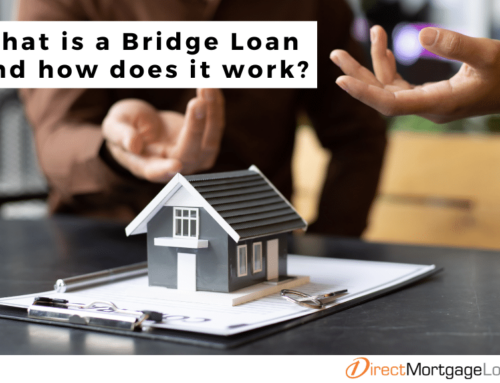For many homeowners, refinancing can feel like a complicated and overwhelming process—but it doesn’t have to be. Before diving into the details of FHA Streamline Refinance, it’s important to understand why this program exists and who it’s designed for. If you’re currently paying off an FHA loan and are looking for a way to reduce your monthly payments, lock in a better rate, or switch to a more stable loan structure, an FHA Streamline Refinance program could be a simple solution. Unlike traditional refinancing, the FHA Streamline Refinance is known for its efficiency and ease, making it an attractive option for eligible homeowners who want to improve their financial situation without the stress of starting from scratch.
Subscribe to our blog to receive notifications of posts that interest you!
What is an FHA Streamline Refinance?
An FHA Streamline Refinance is a refinancing option specifically designed for homeowners who already have an existing FHA loan. Its main purpose is to help reduce monthly mortgage payments or secure a lower interest rate without the heavy documentation typically required for other refinance types. Unlike traditional refinancing, the FHA Streamline process lives up to its name by streamlining the steps needed to qualify.
This program is backed by the Federal Housing Administration and doesn’t typically require a home appraisal, credit check, or income verification. This makes it especially helpful for borrowers whose financial situation has changed or whose home value has declined since their original purchase. Ultimately, it’s a faster, more accessible path to refinancing for many FHA loan holders looking for long-term savings or more manageable payments.
How does a FHA Streamline Refinance work?
An FHA Streamline Refinance allows you to replace your current FHA loan with a new one that offers more favorable terms, like a lower interest rate or a transition from an adjustable-rate to a fixed-rate mortgage. The streamlined nature of this process means you can bypass some of the more time-consuming steps that typically come with refinancing, such as income verification, employment checks, and home appraisals.
The refinance can be structured as either a credit-qualifying or non-credit qualifying option. A credit-qualifying Streamline requires a credit check and more documentation, which may be beneficial if you’re trying to remove a borrower or need to demonstrate ability to repay. On the other hand, a non-credit qualifying Streamline is ideal for borrowers who simply want to take advantage of better terms and are current on their mortgage.
This process is designed to be efficient and borrower-friendly, offering a quick route to savings for eligible homeowners. Because the loan is already insured by the FHA, the risk to lenders is lower, which helps expedite approvals and potentially reduce interest rates.
FHA Streamline Refinance Pros and Cons
Understanding the pros and cons of any mortgage refinance is essential before making a financial decision. The FHA Streamline Refinance program offers unique benefits which could make this refinance program an appealing choice for many homeowners. In this section, we’ll break down the key advantages and disadvantages to help you decide whether this refinancing option aligns with your needs.
FHA Streamline Refinance Pros
- No appraisal required: You do not need to schedule or pay for a new home appraisal, which could save both time and money. This is particularly helpful if your home’s value has decreased or if you’re simply looking to avoid the added step.
- Minimal documentation: Since the original FHA loan already has key information on file, you typically won’t need to submit extensive paperwork. This includes skipping income, employment, and asset verifications in most cases.
- Lower interest rates: When market rates drop, refinancing through the FHA Streamline program could help you secure a better rate. This could lead to substantial monthly savings over the life of your loan.*
- Faster closing process: Because the process is simplified and avoids many of the traditional underwriting steps, you may be able to close on your new loan in as little as 30 days—sometimes even faster.
FHA Streamline Refinance Cons
- Must already have an FHA loan: This refinance program is not available to borrowers with conventional, VA, or USDA loans. You must currently have an FHA-insured mortgage to be eligible.
- No cash-out option: The FHA Streamline Refinance does not allow you to take equity out of your home. If your goal is to access cash for home improvements, debt consolidation, or other expenses, you’ll need to explore other refinancing options.
- Mortgage insurance continues: Even after refinancing, you are still required to pay both the upfront and ongoing annual mortgage insurance premiums (MIP). These added costs could reduce the overall savings potential depending on your new loan terms.
FHA Streamline Refinance Guidelines
To qualify for an FHA Streamline Refinance, borrowers must meet several important requirements that ensure the refinance is both beneficial and financially responsible. These guidelines are designed to protect both the homeowner and the lender while simplifying the process (in comparison to traditional refinance options).
- Your current loan must be FHA-insured: This program is only available to homeowners with an existing FHA-backed mortgage. If your current mortgage is conventional, or backed by another entity like the VA or USDA, you won’t be eligible for this particular refinance option.
- The refinance must provide a net tangible benefit: The new loan must offer a clear financial advantage, such as lowering your monthly payment, reducing your interest rate, or converting from an adjustable-rate mortgage (ARM) to a more stable fixed-rate mortgage. This requirement ensures the refinance truly helps improve your financial situation.
- You must be current on your existing mortgage: To be eligible, you must have a strong recent payment history. Specifically, you cannot have more than one 30-day late payment within the last 12 months. This shows lenders you are capable of managing your mortgage obligations.
- Waiting period required: A minimum of 210 days must have passed since the closing of your original FHA loan. Additionally, you must have made at least six-monthly payments on the loan. This ensures the loan has been seasoned before being refinanced and discourages rapid refinancing that may not provide lasting benefit.
FHA Streamline Refinance vs. Traditional Refinancing
When comparing FHA streamline refinance to traditional refinancing, the differences become clear in terms of both process and requirements. Traditional refinancing is a comprehensive overhaul of your mortgage, often requiring a detailed review of your financial situation. This includes a full credit check, a new home appraisal, employment and income verification, and extensive documentation. It’s a good option for borrowers who want to tap into home equity, switch loan types, or remove mortgage insurance from a conventional loan.
On the other hand, FHA streamline refinance is designed specifically for homeowners with existing FHA loans and focuses on simplifying the process. It typically does not require a credit check, appraisal, or income verification, making it a much quicker and more accessible option—especially for those whose financial or property circumstances may have changed.
Because it’s so streamlined, this option is best for those who simply want to reduce their interest rate, lower monthly payments, or switch from an adjustable-rate to a fixed-rate loan. However, it’s not ideal for borrowers looking to cash out equity or switch loan programs entirely. Each refinancing path has its advantages, so the right choice depends on your unique financial goals and circumstances.
FHA Streamline Refinance Rates Today
FHA streamline refinance rates are often lower than those available through conventional refinancing, making this program an attractive option for eligible homeowners. These rates are determined by several factors, including current market trends, inflation, and overall economic conditions. Because the program is designed to be lower risk for lenders—thanks to the existing FHA insurance—borrowers often benefit from more favorable interest rates.
However, rates are not static. They can fluctuate daily, and even small changes could significantly impact your monthly payments and long-term savings. That’s why it’s important to work closely with a knowledgeable loan officer at Direct Mortgage Loans, who can monitor the market and help you lock in the most competitive rate available at the right time.
In addition to interest rates, be sure to consider the annual percentage rate (APR), which includes lender fees and other costs. Comparing the APR alongside the base interest rate gives you a clearer picture of the total cost of the loan. If you’re unsure where rates currently stand, using an FHA streamline refinance calculator or speaking directly with a loan expert can help you evaluate your potential savings.
Is FHA Streamline Refinance a good idea?
Whether an FHA streamline refinance is a good idea depends largely on your current financial situation and long-term homeownership goals. This refinance option is particularly beneficial if you’re seeking a more manageable monthly payment, a lower interest rate, or a transition from an adjustable-rate to a fixed-rate loan. Because of its streamlined nature—no appraisal, minimal documentation, and faster closing—this type of refinance can be ideal for homeowners who may not qualify for a conventional refinance due to credit or home value limitations.
However, it’s important to weigh the pros and cons. While you may save money on interest and monthly payments, you’ll still be responsible for paying FHA mortgage insurance premiums, which can offset some of those savings over time. Additionally, this program doesn’t allow you to access any of your home’s equity, so if you need cash for renovations or expenses, a different refinancing option may suit you better.
Ultimately, speaking with a trusted loan officer at Direct Mortgage Loans can help you assess whether an FHA streamline refinance aligns with your financial objectives and whether it offers a net tangible benefit based on your unique circumstances.
How To Apply For An FHA Streamline Refinance
Getting started with an FHA streamline refinance is a straightforward process, especially when working with an experienced lender who understands your financial goals. Unlike traditional refinances that require piles of paperwork and multiple verifications, this process is designed to be as efficient and accessible as possible.
- Reach out to a loan officer at Direct Mortgage Loans: Connect with a licensed professional who can evaluate your current mortgage and walk you through your refinancing options. They’ll help determine whether you meet the eligibility requirements and if the program is the right fit.
- Discuss your current FHA loan and financial goals: Share what you’re hoping to achieve—whether it’s reducing your interest rate, stabilizing your monthly payments, or transitioning from an ARM to a fixed-rate loan. This step ensures the refinance meets the net tangible benefit requirement.
- Complete a Streamlined application: Your loan officer will guide you through the simplified application process, which eliminates many of the traditional hurdles such as income or employment verification.
- Provide any required documentation (which is minimal): Depending on the lender and whether your refinance is credit-qualifying or non-credit qualifying, you may only need to provide a few basic documents such as a current mortgage statement or identification.
- Lock in your rate and close your new loan: Once you’ve completed the application and selected the best rate option, you’ll move into closing. Because of the streamlined nature of this process, borrowers could close their new loan in as little as 30 days—sometimes even sooner.**
FHA Streamline Refinance FAQ’s
How long does an FHA Streamline Refinance take?
The timeline for an FHA Streamline Refinance is generally faster than a traditional refinance. Most borrowers can expect the process to take around 30 days or less.** This is largely because the program reduces the need for extensive documentation, income verification, and home appraisal, helping you move from application to closing more efficiently.
What credit score do you need for an FHA Streamline Refinance?
The FHA does not set a strict minimum credit score for streamline refinancing, but many lenders prefer a minimum score of 580. This makes the program accessible to borrowers who may have seen their credit score dip since securing their original FHA loan. Even with a lower score, the non-credit qualifying streamline refinance option could still be available to you if you meet other eligibility criteria. However, keep in mind that a higher credit score may help you secure a better interest rate, and lenders have the discretion to impose their own minimum score requirements.
What documents are required for FHA Streamline Refinance?
One of the major benefits of an FHA streamline refinance is the reduced documentation requirement. Most borrowers only need to provide proof of their current FHA loan, a recent mortgage statement, and valid identification. For non-credit qualifying refinances, you typically do not need to supply pay stubs, tax returns, or employment verification. However, if you are applying for a credit-qualifying version, your lender may ask for income documentation, credit history, and debt-to-income calculations to support your ability to repay the loan.
Does an FHA Streamline Refinance require an appraisal?
Typically, an FHA streamline refinance does not require a new home appraisal, which is one of the program’s most attractive features. This is especially beneficial for homeowners whose property value has declined since their original purchase or who want to avoid the added expense and delays that appraisals can cause. However, in rare cases, such as credit-qualifying streamline refinances or situations involving significant changes in loan terms, a lender may request an appraisal for additional assurance.
Are there closing costs with an FHA Streamline Refinance?
Yes, closing costs still apply, much like any other mortgage transaction. These costs can cover lender origination fees, title insurance, recording fees, and other administrative expenses. The good news is that FHA guidelines offer flexibility: you can often roll these costs into your loan balance if there’s sufficient equity, or you may choose a slightly higher interest rate in exchange for a lender credit that helps offset the fees. Understanding your options can help you minimize out-of-pocket expenses and evaluate your overall savings.
Does FHA Streamline get rid of PMI?
No, an FHA streamline refinance does not eliminate the need for mortgage insurance. Borrowers are still required to pay both an upfront mortgage insurance premium (UFMIP) at the time of closing and ongoing monthly mortgage insurance premiums (MIP). While this might seem like a downside, these premiums help secure your loan and make FHA lending accessible to a wider group of borrowers. The silver lining is that your monthly mortgage insurance cost may decrease if your new loan amount is lower or if the MIP rates have changed since your original loan, which could still lead to reduced overall payments.
*By refinancing your existing loan, total finance charges may be higher over the life of your loan.
**When compared to turn times for conventional programs. Approval times may vary depending on individual circumstances.
***Rates are subject to change. Eligibility and approval is subject to completion of an application and verification of home ownership, occupancy, title, income, employment, credit, home value, collateral and underwriting requirements. Direct Mortgage Loans, LLC NMLS ID# is 832799 (www.nmlsconsumeraccess.com). Direct Mortgage Loans, LLC office is located at 11011 McCormick Rd Ste 400, Hunt Valley, MD 21031.






Leave A Comment
You must be logged in to post a comment.